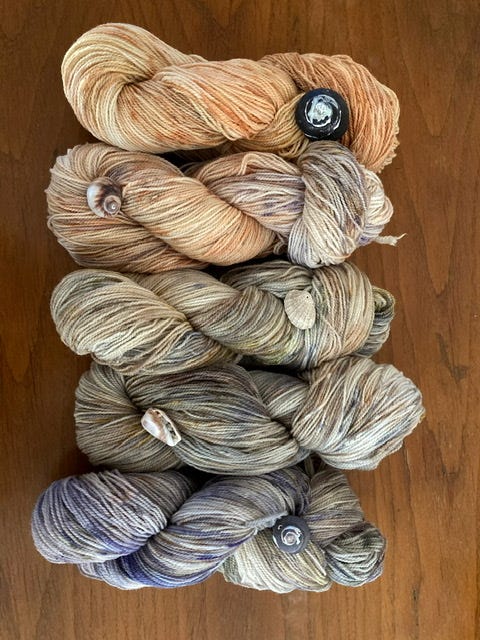March: Color changes with hibiscus
Thoughts on pH, colorfastness and being a responsible business owner
I chose to write about hibiscus this month because it’s in season right now, but I almost changed my mind because I find it a challenging plant to understand within my dye practice. I forage for hibiscus, and since it’s a common plant in gardens here and currently in its blooming season I find flowers available for foraging even when I’m not particularly looking for them. I take only flowers that have already fallen off the plant recently, so that I’m not interrupting any pollination or stealing anyone’s beautiful blooms but I also want flowers that have freshly fallen so they haven’t lost their pigment or gotten too dirty from the ground. Even with these restrictions I have more than I need available to me, so I leave plenty behind.
Hibiscus is a fascinating plant, one whose complexities I’m still working to understand. The main dye chemical group they contain is anthocyanins, which can give lovely, intense colors from pink and purple to blue, green, and gray. My first dye experiments were certainly interesting, but ultimately disappointing: I would extract the color in a dye bath and get an intense fuchsia, then as soon as I added the yarn everything turned a weird and honestly kind of ugly gray. Since it’s not difficult to make a much more stable (and prettier) gray from other plants, I felt it wasn’t worth the trouble.

These color changes, I later learned, happen because anthocyanin dyes are highly sensitive to ph. I wasn’t taking ph measurements at the time of these experiments, but what was likely happening was that I was making neutral to slightly alkaline dye baths with my tap water, which is on the hard side, and then when I added the alum-mordanted yarn the bath became more acidic and changed color. You can play around with ph levels on purpose by adding modifiers such as lemon juice or baking soda to the dye pot to get a wide range of colors.
I’ve had more luck using hibiscus in my bundle dyes. When I use skeins mordanted with alum only, they tend to leave blue and green speckles on the yarn; when I add cream of tartar to the mordant bath I get more purples and pinks. I also tend to get a stronger color impression due to the direct contact between flower and yarn, and bundle dyeing requires less dye material- one flower per skein is usually enough, since I’m using several different dye materials at once in a bundle dye.
While anthocyanins can make stunning colors and are a great way to learn more about the science of natural dyeing, the downside is that they are a less colorfast dye material. I use proper mordanting methods with hibiscus, and I find that the more saturated color impressions of bundle dyeing last longer, but even so, hibiscus will change and fade faster than many of the other materials I use. This is another reason I use it sparingly- in bundle dyes, the hibiscus may degrade faster than other dyes, but the other colors in the material will still keep the skein looking beautiful. It’s also important to keep this in perspective- while hibiscus is on the less colorfast side of dyes, it’s also not a stain that disappears quickly like beets. If my bundle dyed yarns are well cared for and kept out of direct sunlight as much as possible, the color can still be enjoyed for a long time. I’m still using some items knit with bundle dyes that have hibiscus that are a couple years old now.
But, as I move more towards making my yarn production hobby into a tiny business, I may phase out hibiscus and use it only in yarns I’m planning to keep for myself. By selling yarn to others I have a responsibility to make a quality, long-lasting product and I don’t want to contribute to the impression that natural dyes are unreliable or unprofessional. Fugitive dyes have a place, but it’s better to use them in my personal practice and be extra careful with anything I might sell. But helping people understand how all colors change over time is also a part of my practice and my business. I’ve become more comfortable with the living nature of plant color through my practice, and I hope to be able to share that as well.









